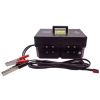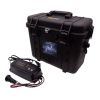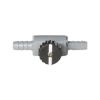Proactive Storm 50 12V Plastic Pump
Features
- Can operate under harsh conditions with higher turbidity
- Sleek outside minimizes well hang-ups
- Can run continuously in water without the need for a cool down
- Free ground shipping
- Expedited repair and warranty service
- Lifetime technical support
- More
Overview
The Proactive Storm 50 pump is capable of pumping up to 50 feet from ground level (DTW) by simply connecting to a 12-volt deep-cycle battery. Its reliable design is perfect for continuous sampling and purging of groundwater wells and low-flow sampling.
Mechanics
The Storm 50 is ideal for low-flow sampling in conjunction with the Low Flow Sampling Controller. Low flow sample all the way down to 40mL per minute. To achieve even a lower flow, simply add the Low Flow Sampling Control Valve in conjunction with the Low Flow Sampling controller to achieve flow rates of 1 mL per minute or less.
Note: All pumps from Proactive are manufactured from PFOA-Free Parts (Except Abyss Pump Line).
- Power Consumption: 60 Watts (max)
- Volt Recommendation: 12-15V at source
- Maximum Amp Output: 4 Amp
- Measurements: 24" length x 0.90" diameter
- Use With: Optional Low Flow Sampling Controller
- Required Tubing: 1/4" or 3/8" ID tubing
- (1) 12V Engineered Plastic Storm 50 pump with 60' wire lead
- (1) Set of 12V battery clamps
In The News
Spring 2025 Environmental Monitor Available Now
In the Spring 2025 edition of the Environmental Monitor, we highlight partnerships across the world and the importance of collaboration between government agencies, universities, environmental groups, local communities, and other stakeholders. From great white shark research in Cape Cod to monitoring fisheries in Lake Erie, this latest edition underscores partnerships that connect stakeholders in a watershed through environmental data. With an emphasis on data sharing, a combination of real-time and discrete sampling keeps the public and partners informed of environmental conditions. Our writers also sought out science professionals dedicated to working with peers within and outside of the environmental sector.
Read MoreMonitoring Mariculture in the Gulf of Alaska
The mariculture industry in the Gulf of Alaska has been steadily growing in recent years, guided by ongoing research to help refine farm location and cultivation practices. A subset of aquaculture, mariculture focuses on rearing organisms in the open ocean. In Alaska, finfish farming is illegal, so most farms cultivate kelp, oysters, or a combination of the two. These small, locally operated farms started popping up in the Gulf of Alaska in the early 1990s, when shellfish farming first became legal. Kelp farming did not begin to catch on in the state until 2016. Many of the coastal areas that have grown interested in mariculture are historically commercial fishing communities.
Read MoreSupplying Seattle’s Drinking Water: Using Data Buoys to Monitor the Cedar River Municipal Watershed
Providing clean, safe, and reliable drinking water for the 1.6 million people in the greater Seattle area is a top priority for Seattle Public Utilities (SPU). With limited water supplies, SPU dedicates considerable resources to maintain its watersheds and mountain reservoirs. About 70 percent of Seattle Water comes from the Cedar River Municipal Watershed , and the other 30 percent comes from the South Fork Tolt River Watershed . [caption id="attachment_39574" align="alignnone" width="940"] Data buoy in Chester Morse Lake . (Credit: Kevin Johnson / Seattle Public Utilities) [/caption] Jamie Thompson, a fisheries biologist at SPU, monitors aquatic ecosystems centered on fish listed under the U.S. Endangered Species Act (ESA).
Read More














